The editor responsibly for Vanity Fair’s popularity was Thomas Gibson Bowles (1841-1922). Having had a privileged upbringing, Bowles pursued literary interests, and in 1868 he borrowed 100 pounds from his friend, Colonel Fred Burnaby, towards the 200 pounds he used to set up Vanity Fair, a weekly magazine of eight to ten pages – “purposed to display the vanities of the week”. His friends were colourful characters of influential status, and they and others like them became both the subjects of his new magazine and its main patrons. While the magazine included news, business, and political events, stories were usually centred around the people involved rather than the news or facts.
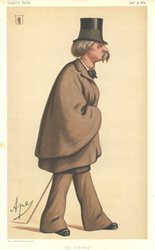 Vanity Fair was the most successful Society magazine
Vanity Fair was the most successful Society magazine 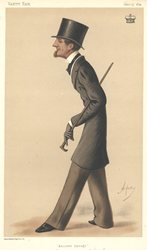
in the history of English journalism, but the magazine’s chief legacy is its caricatures, for their satirical and artistic quality, as well as the historical and biographical value of the text. Most early news journals found that circulation increased enormously following the inclusion of illustrations. Vanity Fair was no different, and a year after commencing publication Bowles included one full-page coloured illustration each week. They were simple caricatures of people who were currently in the news; and they were the perfect accompaniment to the journalistic content which was mostly provided by Bowles as editor, under several different pseudonyms.
In 1869 Bowles employed the Italian artist, Carlo Pellegrini (1839-1889), who had moved from Naples to London in 1864 after his sister died. Pellegrini had mixed with Neapolitan socialites, and rewarded them with good-natured caricatures. Using the pseudonym ‘Ape’ Pellegrini drew caricatures of London personalities for Bowles. The first one published in Vanity Fair, was of Benjamin Disraeli, which Pellegrini signed “Singe” (French for monkey or ape). He then adopted the simpler form “Ape”. Many artists were employed during the 45 years of publication. The other prominent caricaturist was Leslie Ward, "Spy".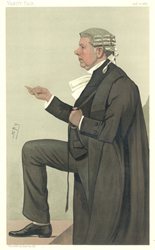
It was the first use of ithography for caricatures. More than 2,300 chrome lithographs (now chromolithographs or colour-printed lithographs) were printed for Vanity Fair by the eminent London lithographer, Vincent Brooks (1814-1885). The caricatures were greatly enjoyed by readers. They increased the sales of Vanity Fair, and also became a recognisable part of British art and history. The popularity of the Vanity Fair caricatures is obvious in their continued use as artwork in restaurants, offices and homes even today.
Each Vanity Fair caricature was of someone who had attracted attention in the news: royalty, the upper-class of society, entertainers and writers, sportsmen and ‘wagerers’, trade union officials and workers, businessmen and politicians (never mutually exclusive), and ‘Men of the Day’ from all walks of life.
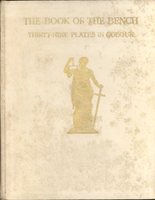 Undoubtedly, the most popular Vanity Fair caricatures have been the humorous images of important people in the legal profession – mostly lawyers and judges in wigs. They were so popular that 39 of the Vanity Fair legal caricatures
Undoubtedly, the most popular Vanity Fair caricatures have been the humorous images of important people in the legal profession – mostly lawyers and judges in wigs. They were so popular that 39 of the Vanity Fair legal caricatures
were reproduced in colour in 1909 for The Book of the Bench. This book of law caricatures was grandly covered in vellum, with a gold embossed figure of Justice with scales and sword on the front cover. 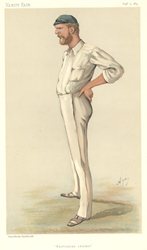
The original text about the 'victim' was printed on thick paper, and the reproduction caricatures (attached to the page along their top edges) are more colourful and slightly smaller than the original lithographs.
The other very popular caricatures are sportsmen - and cricket led the field! Australian Cricket and English Cricket are a wonderful pair. The text adds to the enjoyment of the caricatures. George Bonnor (above) was considered the greatest representative of Australian cricket, and appeared as a caricature in Vanity Fair in 1884. He was described as follows...
“Of English parentage, he was born in Bathurst, New South Wales. He was sent to school and he went into the Bush, attached himself to sheep-farming and learnt to shoot, to ride, and to run, and has now come back to his Mother
-country to represent Australian cricket as one of the Australian Eleven. He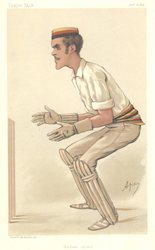 is a quiet, amiable, low-voiced, comely giant, standing six feet in his boots, measuring forty-five inches round the chest, and weighing seventeen stone all but two pounds. He has thrown the cricket-ball 129 yards. He can bowl very fast indeed and is a very hard-hitter. He is a fine runner too, and is the hundred yards' champion of New South Wales. He is neither a smoker nor a drinker, he is gentle and good-humoured, and is altogether a most excellent specimen of the Greater Briton." (We also have the text for English cricket.)
is a quiet, amiable, low-voiced, comely giant, standing six feet in his boots, measuring forty-five inches round the chest, and weighing seventeen stone all but two pounds. He has thrown the cricket-ball 129 yards. He can bowl very fast indeed and is a very hard-hitter. He is a fine runner too, and is the hundred yards' champion of New South Wales. He is neither a smoker nor a drinker, he is gentle and good-humoured, and is altogether a most excellent specimen of the Greater Briton." (We also have the text for English cricket.)
What great respect Bonnor earned. We don't have many Vanity Fair legal caricatures, and even fewer cricketers left. Check them out with these links.
During the years of the Vanity Fair publication, some of the 'victims' were not amused by either their caricature or description. Nevertheless it became a mark of honour to be the target of the magazine's caricaturists. The distinctive style of the lithographic caricatures of Vanity Fair have always been considered a decidedly-English subject but they have been collected worldwide. They are wonderful simple humorous graphics… and it’s always healthy to be able to laugh at human foibles - even our own.